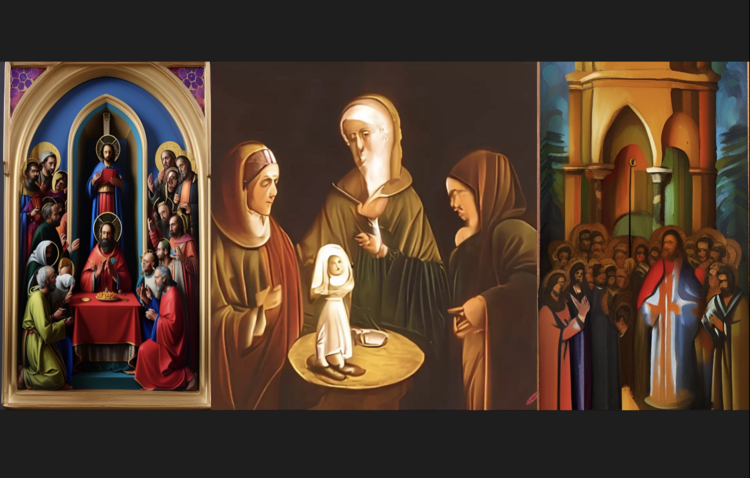Earlier this month on a Catholicism subreddit on Reddit, someone posted an image of the communion of the saints generated by one of the many online artificial intelligence art generators. It put me in mind of the wonderful article written last summer by Stephen McNulty, in which he put the term “Catholicism” into the Dream by Wombo generator’s 22 filters, to see what those depictions might reveal.
Following Mr. McNulty’s example, I asked a dozen different A.I. art generators and filters to consider the term “communion of the saints.” Where Mr. McNulty’s experiment had been marked by a tremendous variety, what was most immediately striking about my own search was the commonalities. Most of the images involved some kind of group gathered in a semi-circle, often around some kind of central figure or object. (In one of the weirdest, from the Craiyon generator, a group of three people in robes stand around a plate on which stands a tiny person wearing huge shoes.)
The images were always set either in some medieval-seeming past or a fantasy-like setting, including one from Nightcafe’s artistic portrait filter that seemed like a scene from the next season of “Lord of the Rings: Rings of Power.” Halos also appear often.
The most striking commonality, and the most concerning, is that in almost all of the pictures where the identities can be determined—A.I. has trouble creating three-dimensional faces—the figures are white men.
But the most striking commonality, and the most concerning, is that in almost all of the pictures where the identities can be determined—A.I. has trouble creating three-dimensional faces—the figures are white men.
Now, if this were just one A.I. generator, you could ask the question: Might this be a function of the algorithm by which the A.I. develops its material? Could it have some in-built implicit bias, as has been discovered in other forms of A.I.? Even with multiple A.I. generators it is still quite possible that bias plays a role.
But as the issue persists across multiple generators, the question eventually becomes whose bias—the generators’ or our own? For comparison, I searched “communion of the saints” on Google to see what would come up there. The top image was from the Archdiocese of San Francisco website, and it portrays a lily-white group of men gathered around the Eucharist. The second came from the top of Wikipedia’s entry for “communion of saints” and depicted John of Patmos, writer of Revelations, looking up to heaven, where a group of white kings are gathered comfortably in thrones around God. The third, from a 2011 U.S. Catholic article on the communion of the saints by Elizabeth Johnson, was the first to have women in the image—a whole row of white women right in the front and another in the middle of its six rows of saints.
Of the first 20 images presented by Google, only four included any people of color, one of them a trippy, photorealistic image from St. Michael Church in Cranford, N.J., which depicts hundreds of almost entirely white male angels descending from a heaven framed in rainbows to come and greet normal people, many of whom are people of color, including for the first time a fair number of children.
When it comes to the communion of the saints, our A.I. seems to be begging a different question entirely: What is it we are teaching ourselves?
I was telling some Catholic friends about all of this. “Well, actually that makes sense,” said one, in a way that signaled his own disappointment. “Most of the saints selected by the church so far have been white men.”
It sounds right, doesn’t it? And certainly the church has selected more than its fair share of white European men over the centuries. But the earliest saints are the Apostles, who as far as we know were all Middle Eastern men. It is the same with Mary and Martha, Mary Magdalene, Joseph and Mary the Mother of God—they were all people of color. And in any tableau of the saints usually they’re the figures front and center—but always depicted as white, like Christ himself.
I remember long ago when I studied at Loyola University Chicago how much I loved looking at the beautiful mural of the Jesuit saints at Madonna della Strada Chapel. But looking at it now, what’s most striking is how many white European Jesuits it includes, and how few of anything else. Historically speaking, most Jesuit martyrs were European missionaries. But they were usually joined in martyrdom by local lay people who were almost always people of color. And yet, other than in the icons of the martyrs of El Salvador, when are those people ever represented? Even the way we talk about them tends to erase their identities; they are simply “…and companions.”
As A.I. art and writing programs have taken off, we have come back to a frequent question: What exactly are we teaching these programs? What are we creating?
But when it comes to the communion of the saints, our A.I. seems to be begging a different question entirely: What is it we are teaching ourselves?








